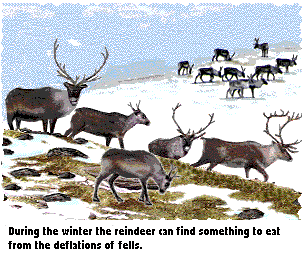Snowcover is divided unevenly especially in open terrain because of wind conditions.
In the fells snow cover is divided particularly unevenly. There are places where the snow cover is durable. There are also places where even during the winter it is nearly snowless. These places are called deflations.
Even many meters of snow can pile up in fell gullys and hollows. From places like these the last snow melts away very late in the summer. They are so-called snow cover durations.
Fell slopes that are against strong wind are, even during winter, almost snowless, that is 'deflated'.

There is usually less snow in the forest, and it is also softer than in open areas. A part of the snow falls on tree branches. On thaw and when it is windy, snow falls off the trees andcondenses into harder snow on the ground, on the outer branches of the trees.
There is not much snow under the trees; snowpits are formed there because some of the snow is left on the branches, and the wind swirls the snow around the tree (windpit). When the sun warms up the trunks of the trees in the springtime snowpits grow, finally forming large bare areas.
In treeless areas (fields, fells, open mires, etc.) the snowcover is thinner but harder than in the forests. Wind carries snow, making snowdrifts is some places and leaving others bare.Snow gathers up close to solid obstacles, but there is usually a spot with little snowright next to an obstacle.
The speed of wind in open terrain is approximately 5 times greater than that in a forest.
The snow wind carries is hard, often 500-1000 g/cm2, whereas the hardness of soft snow is generally only 5-50 g/cm2. The surface snow on fells (so-called windsnow) is often very hard.
See also: The hardness of snow!